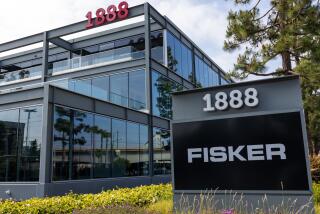Yes to Chrysler and Recovery
- Share via
Shining a light through gloom and confusion, big investors supported Chrysler’s stock offering last week and so signaled that they like the looks of the economy next year.
They also like the looks of Chrysler, for reasons both valid and arguable that say a lot about prospects for the global car industry and offer lessons for all business.
But first, the response by more than 200 institutional and professional investors to Chrysler’s sale of 40 million shares, at prices around $10 a share, was a bet on the economy.
It said U.S. car and truck sales would recover in 1992--a presidential election year. And it said Chrysler would find buyers for its new Jeep Cherokee in the spring and a whole new line of automobiles in the fall that will be priced to compete with the Ford Taurus, Toyota Camry and General Motors’ Pontiac, Oldsmobile and Buick lines.
Chrysler’s big investors were briefed on the new cars and liked what they saw and heard. That’s one reason they bought the stock.
Another reason is that they’re looking for a big payoff. Chrysler is a magic name in investor circles since its spectacular comeback in the 1980s. Chrysler stock rose from under $2 a share, when it was saved by the taxpayers in 1980, to $48 in 1987.
But the company fell on hard times again. It is losing money this year, and its credit rating has has been reduced to junk bond status.
Still, many investors speculate that if its new cars succeed, Chrysler could soar again because it is well positioned for today’s brutally competitive auto markets.
That’s at least partly right. Years of privation have toughened Chrysler, reduced its midriff. The company has cut layers of middle management and produces more vehicles per employee than either Ford or General Motors.
Chrysler’s head of engineering, Francois Castaing, once headed an auto racing team, and the company has adapted a racing team’s agility to designing and making cars, says analyst Joseph Phillippi of the Shearson Lehman investment firm.
The bottom line is that Chrysler can break even if it sells 1.8 million cars a year. And if it sells 2.3 million as it did in 1988, it can earn more than $1 billion, or $3.60 a share, on the present stock. Those were the kinds of calculations that set sugar plums dancing before investors last week.
But life in the auto business is not as easy as in the early ‘80s. Competition is more intense, the oversupply of vehicles is much more severe. In the U.S. market alone, where only about 13 million cars, light trucks and vans will be sold this year, there is capacity of roughly 16 million--a glut approaching 3 million vehicles.
And competition is not simply cutting prices to move cars, either. Rather, the competition, in which Chrysler and U.S. car makers are having difficulty, is technological. Japanese auto makers have developed a lean production system that allows them to bring out new cars quickly, to add features economically and to make money on lower volumes of each model.
“The product cycle in Japan is 4.5 years, the American product cycle eight years,” says Robert Fitzharris, of J. D. Power & Associates, an auto consulting firm. Translated, that means U.S. companies stay too long with the same car and lose customers. For example, General Motors made the Camaro at its Van Nuys plant but didn’t change the car for eight years. Meanwhile, competitors brought out cars with new features--peppier engines, tighter steering, etc.--and made the Camaro look old-fashioned. The result: The Van Nuys plant closed. Competitiveness is not a vague concept; it means jobs and livelihoods. Japanese car makers are approaching 40% of the U.S. car market.
Japanese auto makers did not achieve their adaptability through divine intervention. They got it three decades ago when the Japanese government and auto management combined to defeat an attempt to organize an industry-wide automobile union, on the model of the United Auto Workers. It’s no accident that most Japanese plants in the United States are non-union.
How should U.S. auto workers and manufacturers respond to that? It would help if the UAW and management cooperated to achieve lean and flexible production, as they have in the case of General Motors’ Saturn. That new, low-priced car--$8,500 sticker--is winning customers and will now increase production from 88,000 a year to 228,000.
The challenge of lean production is that it forces competitors to spend in good years and bad to bring out new products, and to adapt quickly to constantly changing customer tastes.
Chrysler runs lean but has had a tough time keeping up with competitive demands for spending. It has budgeted $15 billion for product development during the next five years, but a lot depends on next year and whether the new car lines bring in the profits.
The big investors who bought its stock are saying that an improving economy next year will give Chrysler a shot at those profits.
After that, the company will still have to struggle. But, having come back from near bankruptcy twice in a dozen years, Chrysler has shown it has survival instincts.






